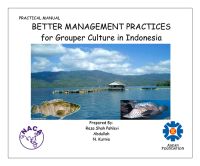This manual is intended for the use by the current and prospective small-scale farmer groups who are interested in obtaining accreditation for their production process. The objective is to provide them an easy-to-follow, stepwise guide that can be used as a practical tool in their venture of attaining group certification. However, this can be used by the field extension officers and certifiers who are directly involved in the process or other interested parties.
This practical manual covers key aspects for successful grouper farming including formation of farmer groups, cage crop planning, crop calendar and better management practices for cage aquaculture of grouper. These include site selection, design, cage preparation, seed selection and stocking practices, feed, water and health management, harvest and post-harvest, record keeping, marketing and capital strengthening. It is designed for use by small-scale farmers.
This practical manual "Better management practices for seaweed farming" is produced by the Philippines national team under the ASEAN Foundation supported project "Strengthening capacity of small holder ASEAN aquaculture farmers for competitive and sustainable aquaculture" implemented by NACA in five ASEAN countries. The long-term objective of the project was to assist ASEAN small- scale aquaculture farmers improve their livelihoods by being competitive in markets and improving farm management practices to deliver quality and sustainably produced aquaculture products.




